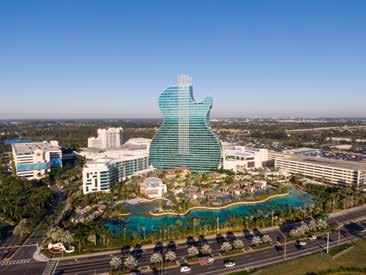
3 minute read
Brian Fink, AIA
from Transcending Luxury
by design et al
PRINCIPAL KLAI JUBA WALD ARCHITECTURE + INTERIORS
Brian Fink has spent over 20 years at Klai Juba Wald, the leading Casino and Entertainment Architecture & Design firm based in Las Vegas. Being a graduate of The University of Nebraska and a licenced architect in the state of Nevada and Arizone, he has taken on leadership roles in the firm and on projects with a focus on hotels and casinos to a great success.

What led you to this career path? From the very beginning I have been interested in design and simply intrigued on how things went together. Interestingly enough, I started out by studying mechanical engineering in school, but after several years, my passion for drawing and design soon led me to architecture and the rest is history.
Please describe the project you are most proud of to date, with reasons why this was a success? The Guitar Hotel because it involved the things I believe are essential to great architecture: Creativity—the vision to create a guitar-shaped hotel—a 450-ft-tall, 596,044-sq-ft guitar tower—was a daunting challenge that our entire team embraced wholeheartedly. Transforming that creative vision into a viable structure involved tremendous resourcefulness in design thinking, structural systems, architectural detailing and construction methods. The project was part of a $1.5 billion, 3.2 million square foot master plan, with multiple construction projects happening simultaneously. We’ve been successful on a number of extremely complex projects, but this one was an exciting achievement for our management and in-the-field construction administration skills.
Please describe a highlight of your career to date. Highlight definitely has to be seeing the successfulness of Klai Juba Wald and that I have been fortunate to be a part of it growing and evolving to what it is today.
Where in the world do you like to retreat to? Wherever my family is…
Has the recent global pandemic changed your outlook on your work? If you’re in this industry long enough, you weather a few storms from economic and natural disasters to this pandemic. I tend to stay calm and stay the course, but I’m naturally a cautious guy. I like to do things well and thoroughly, but architecture is an infinitely creative and adaptable endeavour. If we need to develop a new set of strategies to get something done, that’s what we’ll do. We’re all just much more careful and conscious. We want our people and our clients to stay safe and well.

How do you feel it has changed the world? The hospitality industry has suffered considerably this year. It may take a while to regain our footing. The pandemic has changed the world, but my hope is that we will come out smarter and better prepared for the next big challenge, no matter what it is. If the virus is under control by the end of this year, early next, I think the change will be modest. If it goes on longer, none of us can truly know what will and won’t change and to what degree things will change.
Please tell us your aims for the next twelve months and beyond. We want to be able to be here for our clients and help them find ways to navigate through this ever changing environment and provide them the ability to find new and creative ways of looking at themselves and their own built environment.
How will it change the global design sector? The design sector is infinitely creative and adaptable. Architectural practice is continually changing, with new systems for designing, documenting and analysing design work emerging all the time. I’m hoping we see new innovation in materials and building systems and even more evolution in the technology we use to design buildings. We’re already strategizing on what we can do differently to accommodate the challenges that have arisen with the pandemic both in our office and for our clients and their projects.
What would be your key piece of advice for emerging designers right now? Stick with it. Use this time to study or take exams. Find a mentor who is in practice—you can do this through your local chapter of the AIA or the IDA, or the architectural or design association in your country. If you have to take a job in another sector, come back to architecture and design. We welcome insight from all disciplines, so whatever you do, it will just add to your work as a designer. This isn’t the first time graduates have faced a tough job market. Hang in there. We’ll need you in the future.











